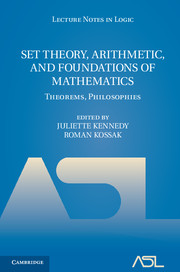Book contents
- Frontmatter
- Contents
- Introduction
- Historical remarks on Suslin's problem
- The continuum hypothesis, the generic-multiverse of sets, and the Ω conjecture
- ω-models of finite set theory
- Tennenbaum's theorem for models of arithmetic
- Hierarchies of subsystems of weak arithmetic
- Diophantine correct open induction
- Tennenbaum's theorem and recursive reducts
- History of constructivism in the 20th century
- A very short history of ultrafinitism
- Sue Toledo's notes of her conversations with Gödel in 1972–5
- Stanley Tennenbaum's Socrates
- Tennenbaum's proof of the irrationality of √2
Tennenbaum's proof of the irrationality of √2
Published online by Cambridge University Press: 07 October 2011
- Frontmatter
- Contents
- Introduction
- Historical remarks on Suslin's problem
- The continuum hypothesis, the generic-multiverse of sets, and the Ω conjecture
- ω-models of finite set theory
- Tennenbaum's theorem for models of arithmetic
- Hierarchies of subsystems of weak arithmetic
- Diophantine correct open induction
- Tennenbaum's theorem and recursive reducts
- History of constructivism in the 20th century
- A very short history of ultrafinitism
- Sue Toledo's notes of her conversations with Gödel in 1972–5
- Stanley Tennenbaum's Socrates
- Tennenbaum's proof of the irrationality of √2
Summary
The proof of the irrationality of √2 involves proving that there cannot be positive integers n and m such that n2 = 2m2. This can be proved with a simple number-theoretic argument: First we note that n must be even, whence m must also be even, and hence both are divisible by 2. Then we observe that this is a contradiction if we assume that n is chosen minimally. There is also a geometric proof known already to Euclid, but the proof given by Tennenbaum seems to be entirely new. It is as follows: In Picture 1 we have on the left hand side two squares superimposed, one solid and one dashed. Let us assume that the area of the solid square is twice the area of the dashed square. Let us also assume that the side of each square is an integer and moreover the side of the solid square is as small an integer as possible. In the right hand side of Picture 1 we have added another copy of the dashed square to the lower left corner of the solid square, thereby giving rise to a new square in the middle and two small squares in the corners. The combined area of the two copies of the original dashed square is the same as the area of the original big solid square. In the superimposed picture the middle square gets covered by a dashed square twice while the small corner squares are not covered by the dashed squares at all. Hence the area of the middle square must equal the combined area of the two corner squares.
Information
- Type
- Chapter
- Information
- Set Theory, Arithmetic, and Foundations of MathematicsTheorems, Philosophies, pp. 226 - 227Publisher: Cambridge University PressPrint publication year: 2011
